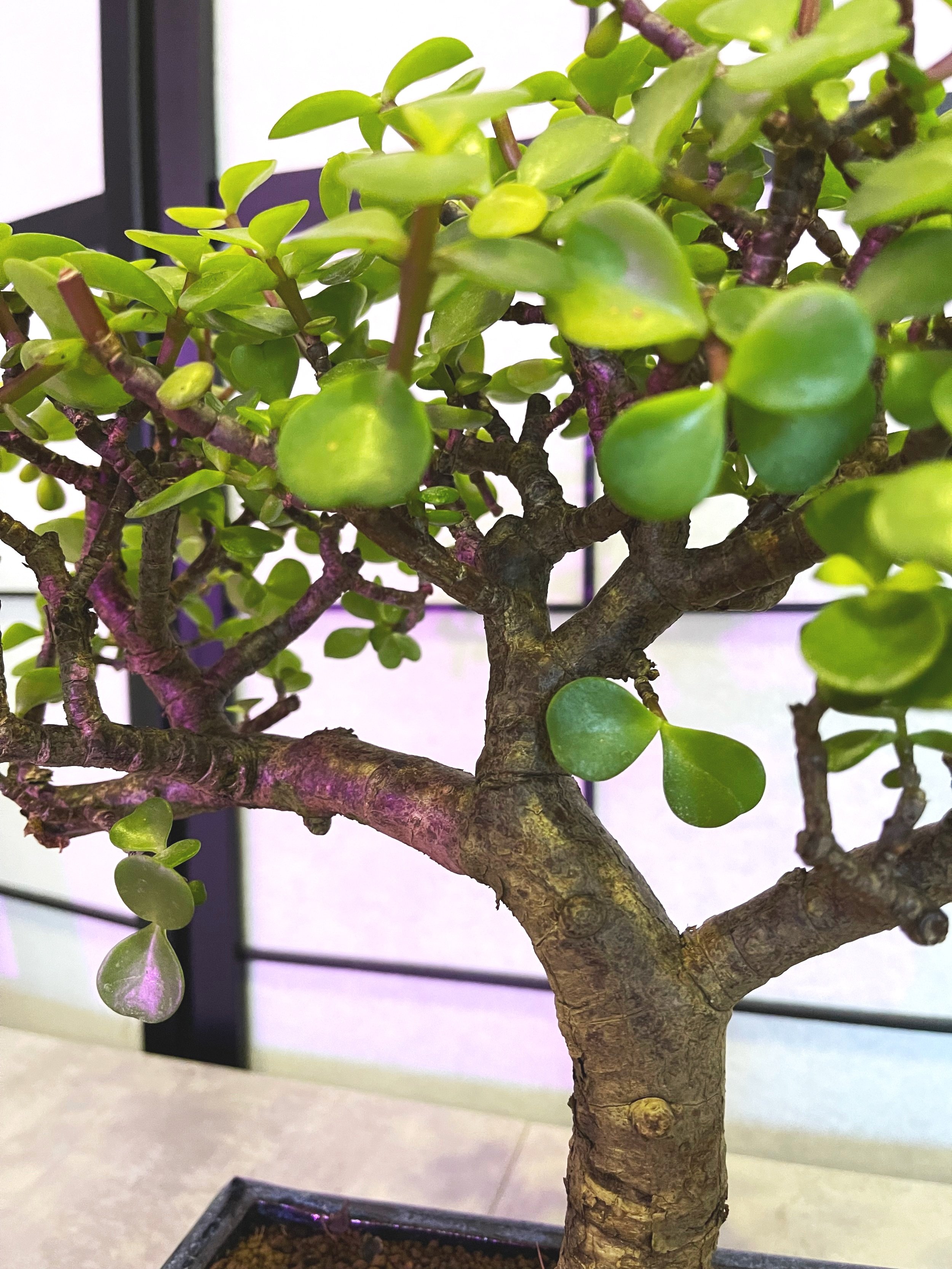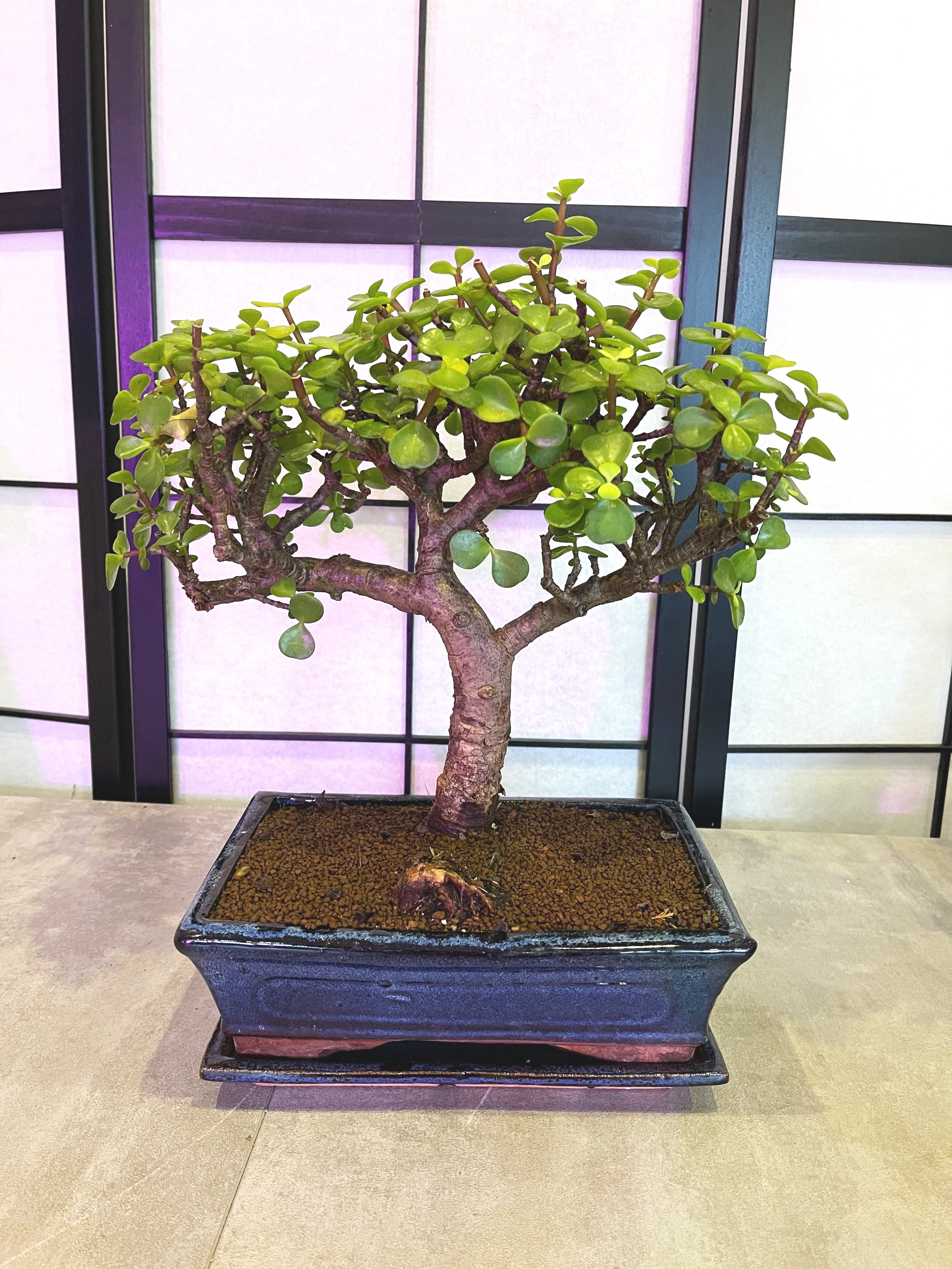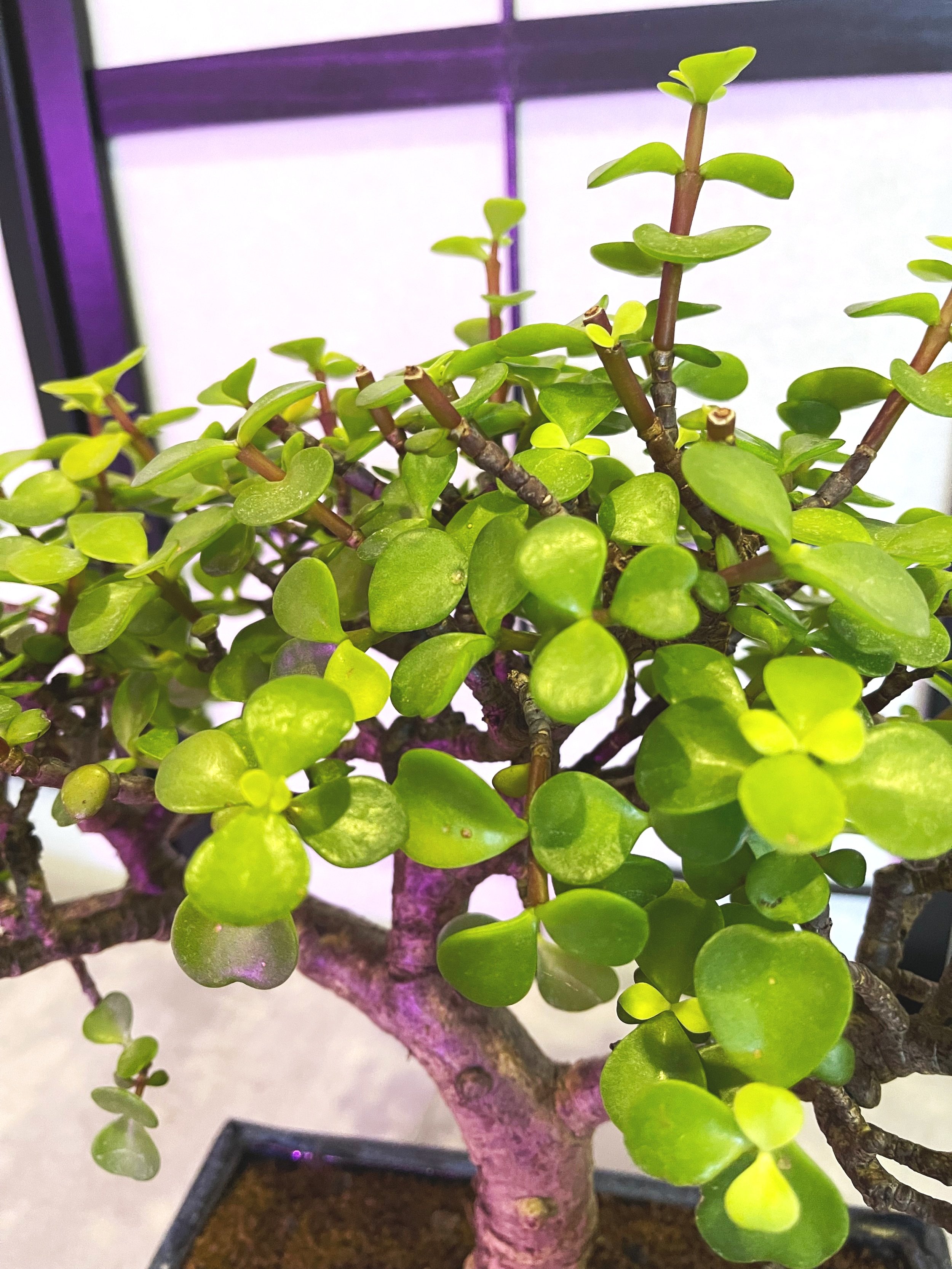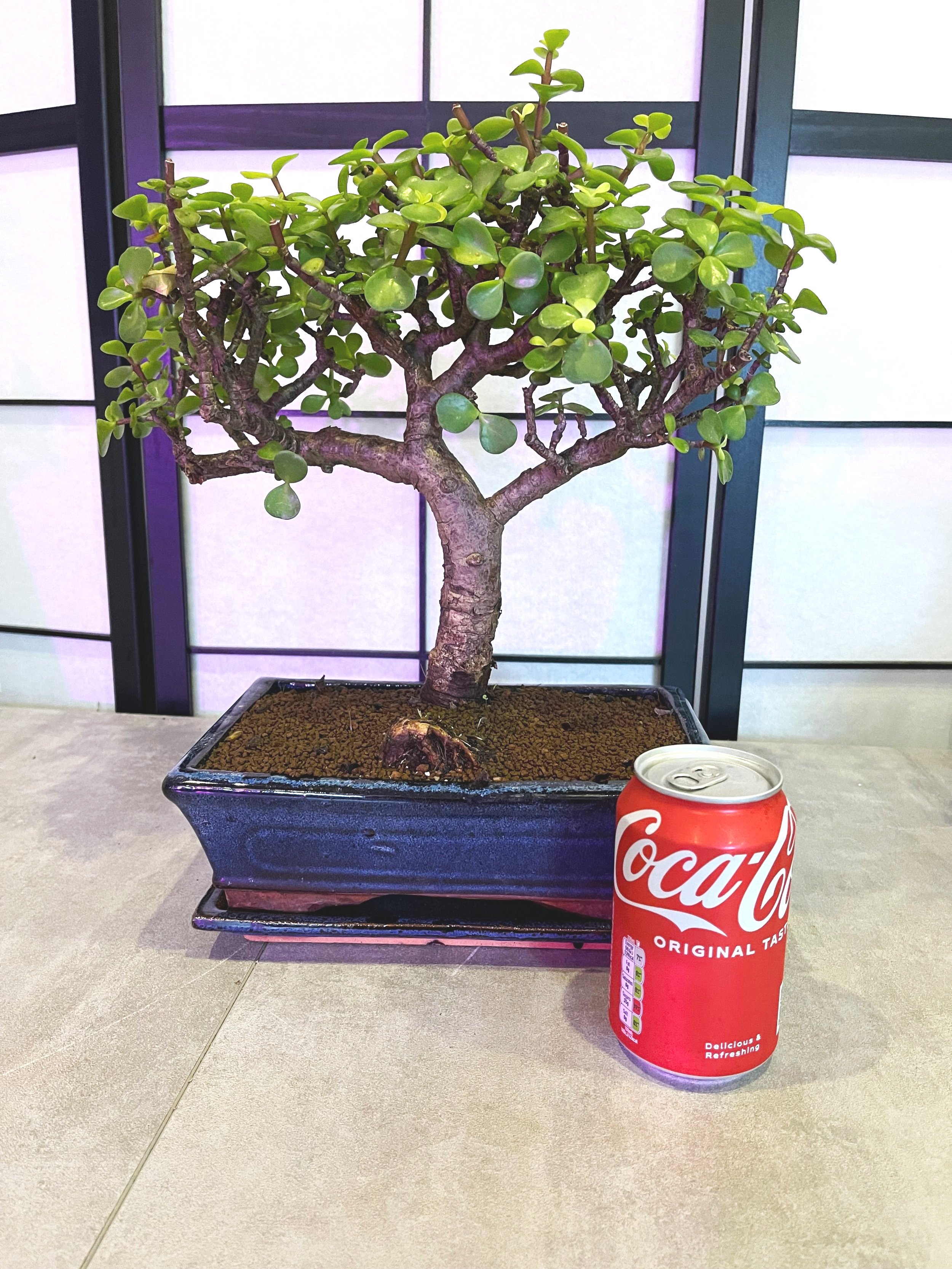 Image 1 of 4
Image 1 of 4

 Image 2 of 4
Image 2 of 4

 Image 3 of 4
Image 3 of 4

 Image 4 of 4
Image 4 of 4





Dwarf Jade Bonsai (Elephant Bush) 40cm
The Dwarf Jade Bonsai, also known as Elephant Bush (Portulacaria afra), is a popular choice for bonsai enthusiasts due to its unique appearance and ease of care. This hardy succulent is native to South Africa and can thrive indoors or outdoors with the right care. In this guide, we'll provide you with essential care information to help your Dwarf Jade Bonsai thrive.
Size: 40cm
Light Requirements: Dwarf Jade Bonsai plants love bright, indirect sunlight. Place your bonsai near a sunny window, preferably one that receives morning sunlight. If grown outdoors, partial sun to full sun is ideal.
Temperature: Maintain a warm environment for your Dwarf Jade Bonsai. They prefer temperatures between 65°F to 75°F (18°C to 24°C). Protect them from cold drafts during winter.
Watering:
Water your Dwarf Jade Bonsai sparingly. Allow the top inch (2.5 cm) of the soil to dry out between waterings.
Ensure that the pot has good drainage to prevent waterlogged soil, which can lead to root rot.
During the growing season (spring and summer), water more frequently but still allow the soil to dry out slightly between waterings.
In winter, reduce watering as the plant's growth slows down.
Soil: Use a well-draining succulent or cactus soil mix. You can also add some perlite or sand to improve drainage. Repot your bonsai every 2-3 years to refresh the soil and provide more space for root growth.
Fertilising: Feed your Dwarf Jade Bonsai with a balanced, diluted liquid fertiliser during the growing season (spring and summer) every 4-6 weeks. Reduce or cease fertilisation during the dormant winter months.
Pruning and Styling: Dwarf Jade Bonsai respond well to pruning and shaping. Use sharp bonsai shears to trim and shape your plant. Regular pruning will help maintain the desired bonsai shape.
Pests and Diseases: Dwarf Jade Bonsai are generally resistant to most pests and diseases. However, be on the lookout for signs of mealybugs, spider mites, or scale insects. Treat any infestations promptly with neem oil or insecticidal soap.
Repotting: Repot your Dwarf Jade Bonsai every 2-3 years in the spring. Choose a slightly larger pot and trim the roots as needed. Refresh the soil and ensure good drainage.
Indoor vs. Outdoor: You can grow Dwarf Jade Bonsai both indoors and outdoors. Indoor bonsais should still receive ample sunlight and may benefit from occasional outdoor exposure during the growing season.
Conclusion: The Dwarf Jade Bonsai, with its unique trunk and glossy leaves, is a captivating addition to any bonsai collection. With proper care, this hardy succulent can thrive for many years, making it an excellent choice for both beginners and experienced bonsai enthusiasts. Remember to adjust your care routine based on your specific climate and conditions to ensure the health and vitality of your Dwarf Jade Bonsai. Happy bonsai gardening!
The Dwarf Jade Bonsai, also known as Elephant Bush (Portulacaria afra), is a popular choice for bonsai enthusiasts due to its unique appearance and ease of care. This hardy succulent is native to South Africa and can thrive indoors or outdoors with the right care. In this guide, we'll provide you with essential care information to help your Dwarf Jade Bonsai thrive.
Size: 40cm
Light Requirements: Dwarf Jade Bonsai plants love bright, indirect sunlight. Place your bonsai near a sunny window, preferably one that receives morning sunlight. If grown outdoors, partial sun to full sun is ideal.
Temperature: Maintain a warm environment for your Dwarf Jade Bonsai. They prefer temperatures between 65°F to 75°F (18°C to 24°C). Protect them from cold drafts during winter.
Watering:
Water your Dwarf Jade Bonsai sparingly. Allow the top inch (2.5 cm) of the soil to dry out between waterings.
Ensure that the pot has good drainage to prevent waterlogged soil, which can lead to root rot.
During the growing season (spring and summer), water more frequently but still allow the soil to dry out slightly between waterings.
In winter, reduce watering as the plant's growth slows down.
Soil: Use a well-draining succulent or cactus soil mix. You can also add some perlite or sand to improve drainage. Repot your bonsai every 2-3 years to refresh the soil and provide more space for root growth.
Fertilising: Feed your Dwarf Jade Bonsai with a balanced, diluted liquid fertiliser during the growing season (spring and summer) every 4-6 weeks. Reduce or cease fertilisation during the dormant winter months.
Pruning and Styling: Dwarf Jade Bonsai respond well to pruning and shaping. Use sharp bonsai shears to trim and shape your plant. Regular pruning will help maintain the desired bonsai shape.
Pests and Diseases: Dwarf Jade Bonsai are generally resistant to most pests and diseases. However, be on the lookout for signs of mealybugs, spider mites, or scale insects. Treat any infestations promptly with neem oil or insecticidal soap.
Repotting: Repot your Dwarf Jade Bonsai every 2-3 years in the spring. Choose a slightly larger pot and trim the roots as needed. Refresh the soil and ensure good drainage.
Indoor vs. Outdoor: You can grow Dwarf Jade Bonsai both indoors and outdoors. Indoor bonsais should still receive ample sunlight and may benefit from occasional outdoor exposure during the growing season.
Conclusion: The Dwarf Jade Bonsai, with its unique trunk and glossy leaves, is a captivating addition to any bonsai collection. With proper care, this hardy succulent can thrive for many years, making it an excellent choice for both beginners and experienced bonsai enthusiasts. Remember to adjust your care routine based on your specific climate and conditions to ensure the health and vitality of your Dwarf Jade Bonsai. Happy bonsai gardening!
The Dwarf Jade Bonsai, also known as Elephant Bush (Portulacaria afra), is a popular choice for bonsai enthusiasts due to its unique appearance and ease of care. This hardy succulent is native to South Africa and can thrive indoors or outdoors with the right care. In this guide, we'll provide you with essential care information to help your Dwarf Jade Bonsai thrive.
Size: 40cm
Light Requirements: Dwarf Jade Bonsai plants love bright, indirect sunlight. Place your bonsai near a sunny window, preferably one that receives morning sunlight. If grown outdoors, partial sun to full sun is ideal.
Temperature: Maintain a warm environment for your Dwarf Jade Bonsai. They prefer temperatures between 65°F to 75°F (18°C to 24°C). Protect them from cold drafts during winter.
Watering:
Water your Dwarf Jade Bonsai sparingly. Allow the top inch (2.5 cm) of the soil to dry out between waterings.
Ensure that the pot has good drainage to prevent waterlogged soil, which can lead to root rot.
During the growing season (spring and summer), water more frequently but still allow the soil to dry out slightly between waterings.
In winter, reduce watering as the plant's growth slows down.
Soil: Use a well-draining succulent or cactus soil mix. You can also add some perlite or sand to improve drainage. Repot your bonsai every 2-3 years to refresh the soil and provide more space for root growth.
Fertilising: Feed your Dwarf Jade Bonsai with a balanced, diluted liquid fertiliser during the growing season (spring and summer) every 4-6 weeks. Reduce or cease fertilisation during the dormant winter months.
Pruning and Styling: Dwarf Jade Bonsai respond well to pruning and shaping. Use sharp bonsai shears to trim and shape your plant. Regular pruning will help maintain the desired bonsai shape.
Pests and Diseases: Dwarf Jade Bonsai are generally resistant to most pests and diseases. However, be on the lookout for signs of mealybugs, spider mites, or scale insects. Treat any infestations promptly with neem oil or insecticidal soap.
Repotting: Repot your Dwarf Jade Bonsai every 2-3 years in the spring. Choose a slightly larger pot and trim the roots as needed. Refresh the soil and ensure good drainage.
Indoor vs. Outdoor: You can grow Dwarf Jade Bonsai both indoors and outdoors. Indoor bonsais should still receive ample sunlight and may benefit from occasional outdoor exposure during the growing season.
Conclusion: The Dwarf Jade Bonsai, with its unique trunk and glossy leaves, is a captivating addition to any bonsai collection. With proper care, this hardy succulent can thrive for many years, making it an excellent choice for both beginners and experienced bonsai enthusiasts. Remember to adjust your care routine based on your specific climate and conditions to ensure the health and vitality of your Dwarf Jade Bonsai. Happy bonsai gardening!